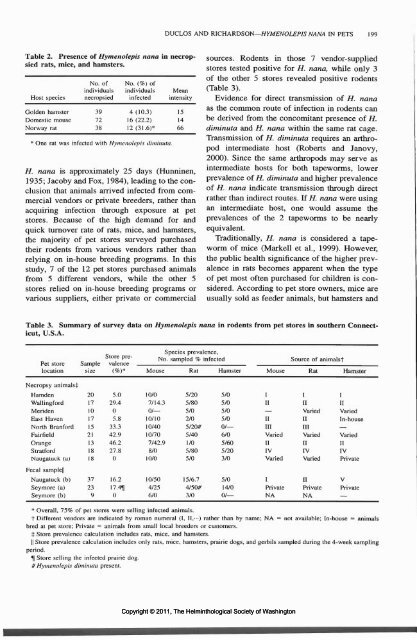Comparative Parasitology 67(2) 2000 - Peru State College
Comparative Parasitology 67(2) 2000 - Peru State College
Comparative Parasitology 67(2) 2000 - Peru State College
You also want an ePaper? Increase the reach of your titles
YUMPU automatically turns print PDFs into web optimized ePapers that Google loves.
Table 2. Presence of Hymenolepis nana in necropsied<br />
rats, mice, and hamsters.<br />
No. of No. (%) of<br />
individuals individuals Mean<br />
Host species necropsied infected intensity<br />
Golden hamster<br />
Domestic mouse<br />
Norway rat<br />
39<br />
72<br />
38<br />
4 (10.3)<br />
16 (22.2)<br />
12 (31.6)*<br />
* One rat was infected with Hymenolepis dimimita.<br />
DLJCLOS AND RICHARDSON—HYMENOLEPIS NANA IN PETS 199<br />
15<br />
14<br />
66<br />
H. nana is approximately 25 days (Hunninen,<br />
1935; Jacoby and Fox, 1984), leading to the conclusion<br />
that animals arrived infected from commercial<br />
vendors or private breeders, rather than<br />
acquiring infection through exposure at pet<br />
stores. Because of the high demand for and<br />
quick turnover rate of rats, mice, and hamsters,<br />
the majority of pet stores surveyed purchased<br />
their rodents from various vendors rather than<br />
relying on in-house breeding programs. In this<br />
study, 7 of the 12 pet stores purchased animals<br />
from 5 different vendors, while the other 5<br />
stores relied on in-house breeding programs or<br />
various suppliers, either private or commercial<br />
sources. Rodents in those 7 vendor-supplied<br />
stores tested positive for H. nana, while only 3<br />
of the other 5 stores revealed positive rodents<br />
(Table 3).<br />
Evidence for direct transmission of H. nana<br />
as the common route of infection in rodents can<br />
be derived from the concomitant presence of H.<br />
dimimita and H. nana within the same rat cage.<br />
Transmission of H. diminuta requires an arthropod<br />
intermediate host (Roberts and Janovy,<br />
<strong>2000</strong>). Since the same arthropods may serve as<br />
intermediate hosts for both tapeworms, lower<br />
prevalence of H. diminuta and higher prevalence<br />
of H. nana indicate transmission through direct<br />
rather than indirect routes. If H. nana were using<br />
an intermediate host, one would assume the<br />
prevalences of the 2 tapeworms to be nearly<br />
equivalent.<br />
Traditionally, H. nana is considered a tapeworm<br />
of mice (Markell et al., 1999). However,<br />
the public health significance of the higher prevalence<br />
in rats becomes apparent when the type<br />
of pet most often purchased for children is considered.<br />
According to pet store owners, mice are<br />
usually sold as feeder animals, but hamsters and<br />
Table 3. Summary of survey data on Hymenolepis nana in rodents from pet stores in southern Connecticut,<br />
U.S.A.<br />
Pet store Sample<br />
location size<br />
Necropsy animals:]:<br />
Hamden<br />
Wallingford<br />
Meriden<br />
East Haven<br />
North Branford<br />
Fairrield<br />
Orange<br />
Stratford<br />
Naugatuck (a)<br />
Fecal sample||<br />
Naugatuck (b)<br />
Seymore (a)<br />
Seymore (b)<br />
20<br />
17<br />
10<br />
17<br />
15<br />
21<br />
13<br />
18<br />
18<br />
37<br />
23<br />
9<br />
Store prevalence<br />

















